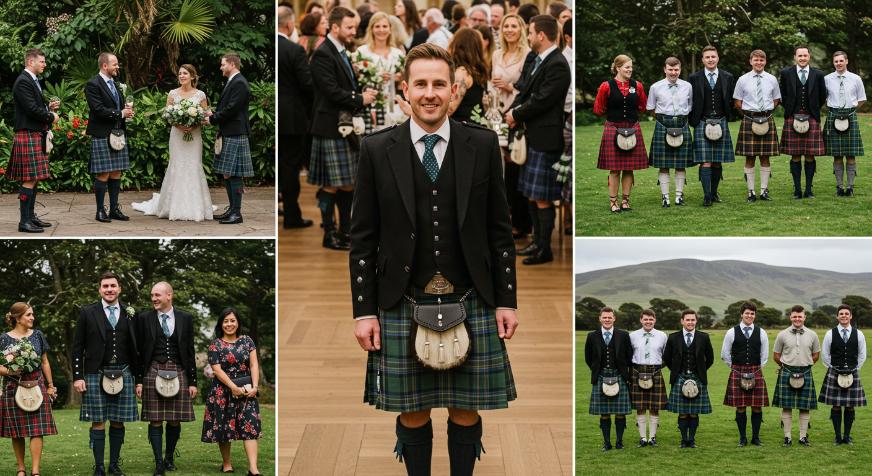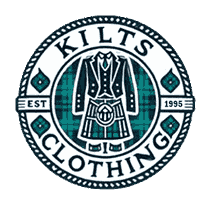The Global Appeal of Formal Kilts: How Highland Dress Transcends Borders

Once a humble garment worn primarily in the Scottish Highlands, Kilts have transcended their regional origins to become a globally recognized symbol of culture, heritage, and style. Today, the formal kilt is embraced in Scotland and worldwide, gracing weddings, galas, festivals, and fashion runways across continents. This blog delves into the global appeal of formal kilts, exploring how this iconic piece of Scottish attire has earned its place on the international stage and continues to thrive across borders.
The Historical Roots of the Kilt: A Scottish Tradition
The kilt's story begins in the rugged Scottish Highlands, where it was initially crafted as a practical garment to endure the harsh climate and terrain. Its roots can be traced back to the 16th century, with early versions of the kilt referred to as the "belted plaid." The kilt was initially a large piece of cloth wrapped around the body, fastened with a belt, and worn with a cloak. Over time, it evolved into the more refined form we recognize today.
The kilt's distinctive tartan patterns became a symbol of Scottish clan identity. Each clan had its unique tartan, which was worn as a way of showing allegiance and pride in one's heritage. Beyond its utilitarian beginnings, the kilt became a ceremonial garment worn for weddings, military events, and other special occasions.
The Kilt's International Journey: From Scotland to the World
The spread of Scottish emigration during the 18th and 19th centuries played a significant role in the global reach of the kilt. Scottish immigrants brought their cultural traditions, including the kilt, to countries such as Canada, the United States, Australia, and New Zealand. In these countries, the kilt was adopted as a symbol of Scottish heritage and pride, especially during celebrations like Tartan Day in North America and Burns Night in many parts of the world.
The kilt's appeal extended far beyond the Scottish diaspora. By the 20th century, the Highland dress was worn by individuals of all nationalities who appreciated its aesthetic and symbolic value. As the world became more interconnected, interest in Scottish culture and traditions grew, and the kilt became a garment for the Scots and anyone looking to celebrate or connect with this rich heritage.
Formal Kilts on the International Stage: Weddings, Galas, and State Events
One of the most significant ways formal kilt wear have gained international popularity is through their presence at weddings, galas, and state events. In many parts of the world, the formal kilt has become a preferred attire for groom and groomsmen at Scottish or Scottish-inspired weddings. Whether worn with a Prince Charlie jacket or a more contemporary style, the kilt offers a distinctive and elegant look that stands out at any wedding.
In addition to weddings, formal kilts have also made their mark at high-profile galas and state functions. At these events, individuals wearing kilts stand out for their bold attire, adding a touch of tradition and flair to the proceedings. Kilts have been seen at royal events, diplomatic dinners, and high-society gatherings, where they are worn with pride and elegance, often paired with fine accessories like sporrans, kilt pins, and brogues.
The Kilt as a Symbol of Cultural Heritage and Identity
Beyond its role in a formal fashion, the kilt has become a powerful symbol of cultural pride. For Scottish people, the kilt is a garment and a connection to their heritage, history, and clan identity. Even those who have moved away from Scotland continue to wear the kilt to preserve and celebrate their roots.
The kilt's significance extends to the broader Scottish diaspora, including communities in countries such as the United States, Canada, and Australia, where it serves as a cultural touchstone. Wearing a kilt at cultural events like Highland Games or Burns Night celebrations allows individuals to honor their Scottish ancestry and participate in a shared artistic experience. Additionally, the kilt has been adopted by individuals from other backgrounds who seek to express their connection to Scottish traditions, whether through familial ties or personal admiration for the culture.
The Role of Modern Fashion and Global Trends in Kilt Popularity
The resurgence of interest in Highland dress can also be attributed to its adoption by the fashion world. High fashion designers have long been fascinated by the unique aesthetic of the kilt, incorporating it into their collections for both men and women. The kilt's bold lines, distinctive tartans, and dramatic flair make it a captivating garment on the runway.
In recent years, kilts have increasingly found their place in modern fashion, particularly streetwear and contemporary high fashion. Designers have modernized the kilt by experimenting with different fabrics, cuts, and accessories, making it a versatile piece that can be worn at formal events or as part of a stylish everyday look.
The trend of hybrid or unisex kilts has further expanded the garment's appeal, making it more accessible to a broader range of individuals. These modern iterations of the kilt maintain the spirit of the traditional garment while adapting it to contemporary sensibilities. This shift has helped the kilt transcend its traditional associations, making it a statement of individuality and style for people of all backgrounds.
Highland Games and Festivals: Global Gatherings Celebrating Scottish Culture
One of the most visible ways the kilt is celebrated globally is through events like the Highland Games, which occur in cities worldwide. The Highland Games, held initially in Scotland, have become an international phenomenon, with festivals and competitions organized in places as far away as the United States, Canada, Australia, and New Zealand.
Participants don the kilt at these events to symbolize their connection to Scottish culture. The games feature traditional Scottish sports, such as caber tossing and tug-of-war, as well as Scottish music and dance performances. The kilt is worn by participants and spectators, who take pride in showcasing their Scottish heritage or their admiration for Scottish culture.
Highland Games and similar festivals offer a chance for people to come together, celebrate their heritage, and wear the kilt in a vibrant and communal setting. These gatherings are an essential way in which the kilt has transcended borders and become a global symbol of cultural pride and unity.
Global Adoption of Kilts in Military and Regimental Wear
The kilt's presence is not limited to civilian life; it has also played a significant role in military and regimental wear. The British Army, for instance, has long featured kilts as part of ceremonial uniforms, particularly for regiments like the Royal Regiment of Scotland and the Black Watch. Kilts are worn during formal military events and parades, symbolizing regimental pride and tradition.
Kilts have also been adopted by other countries' armed forces, often as part of ceremonial uniforms. This global adoption of the kilt in military settings has further contributed to its international recognition and status as a symbol of dignity, honor, and heritage.
The Appeal of Kilts in Fashion Capitals: London, Paris, New York
As kilts have gained recognition globally, they have also captured the attention of fashion capitals like London, Paris, and New York. These cities, known for their influential fashion scenes, have embraced the kilt as a distinctive piece of formal attire and avant-garde streetwear. Designers have showcased kilts in their runway collections, blending traditional Scottish elements with modern, global fashion trends.
The kilt's versatility—elegant enough for a formal gala yet edgy sufficient for a fashion-forward look—has made it a popular choice for designers and consumers alike. Celebrities and public figures have also contributed to the global appeal of the kilt, often seen sporting the garment on high-profile occasions.
The Future of Formal Kilts: Trends and Innovations
Looking ahead, the future of formal kilts seems bright. With a growing focus on sustainability and ethical fashion, many kilt makers are embracing eco-friendly materials and practices, ensuring that kilts remain a viable option for modern consumers. Additionally, tailoring and fabric technology innovations are helping to create lighter, more comfortable kilts that are easier to wear year-round.
The popularity of the kilt is likely to continue expanding, driven by its ability to adapt to modern tastes while maintaining its rich cultural heritage. As more people worldwide embrace the kilt, it will remain a timeless garment that transcends borders and brings people together through fashion, culture, and tradition.
Conclusion:
From its roots in the Scottish Highlands to its global popularity today, the formal kilt has become an enduring symbol of heritage, pride, and elegance. Whether worn at weddings, galas, Highland Games, or fashion runways, the kilt continues to captivate people worldwide with its bold aesthetic and cultural significance. As the kilt transcends borders and generations, it reminds us that fashion, much like heritage, can unite us all, no matter where we come from.


